Okay, so understand that I know no one in Madison, Wisconsin. No one. I was there on a cheesemakers’ junket (fully underwritten by the Wisconsin Milk Marketing Board; consider that disclosure) on Friday, and the first moment I had free to wander the city, I went over to a highly praised cheese shop, Fromagination.
And I immediately saw someone I knew.
In the city where I know no one.
It was Tim Dahl, former pastry chef of Blackbird, who appeared wittingly in Sky Full of Bacon #6 (the second half of the mulefoot pig saga) and unwittingly at the beginning of Sky Full of Bacon #8 (the one about Oriana’s Asian pears, which he had commented on during the mulefoot shoot and used in his dessert). “Tim Dahl!” I said.
He turned to me with the look of a man on the ten-most wanted list who has finally come face to face with the FBI. I reintroduced myself and said I had heard he was opening a restaurant here with his wife, Elizabeth, formerly the very wonderful pastry chef of Boka/Landmark.
“We’re opening tonight. In ten minutes,” he said, sort of shaking like he was attached to an exercise machine. “And— we— don’t— have… cheese!”
I let him get his cheese and wished him luck as he went out the door, vibrating like a tuning fork.

An hour or two later we were being seated in the private room of L’Etoile, just around the corner. L’Etoile has long been Madison’s best and most influential restaurant, to Madison restaurants what Mount Rushmore is to reasons to visit South Dakota. Food media always talks about Alice Waters, because they always talk about people on the coasts and barely know the midwest exists, but Odessa Piper, who started L’Etoile in an old brownstone in 1976, is probably just as important a figure in terms of working as a restaurateur to foster better farmers, cheesemakers, everything from the fertile farmland around her. If she had been in California and Waters in Wisconsin, she’d be the one you’d have heard of.
But if the above photo doesn’t exactly look like a cozy post-hippie university town place in an old brownstone, it’s because Piper sold L’Etoile in 2005 to employee turned current chef Tory Miller and a couple of backers including his sister, and in August it moved to much glitzier surroundings opposite the capitol building. (Madison, like Austin, Texas, manages the neat feat of being both a laidback post-hippie college town and a den of legislative inquity, which if nothing else, seems to be good for the restaurant scene.)
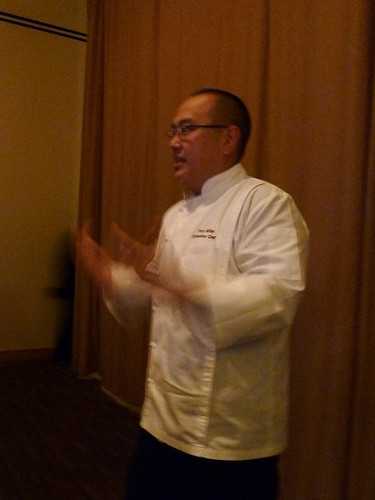
So I knew why L’Etoile mattered to the history of midwestern dining; what I didn’t necessarily know was whether it still did, or whether the many farmer’s-market-shopping chefs and restaurants that had followed it, not only in Madison but all around, had surpassed it. Certainly Miller still talked the talk, since the menu was dotted with the products of artisanal cheesemakers we had met during the trip, and he spoke about his own interest in the cheese scene and a cheesemaker who was our guest at dinner, Brenda Jensen of Hidden Springs Farm, who shared with us one of her newest cheeses, a sheep-cow blend called Meadow Melody.
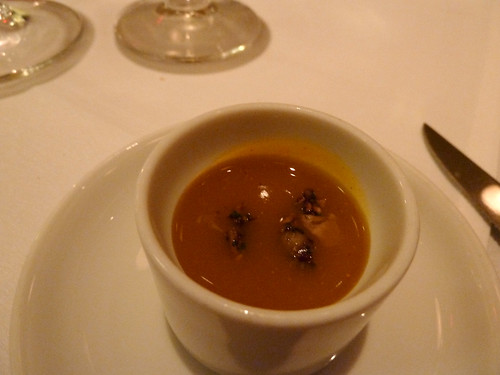
The first bites immediately made it clear that L’Etoile was serious about great farm produce— starting with the butter. How many restaurants make their own butter? Not many outside of Wisconsin, I expect, but if they tried this butter, they would— it was fresh the way buffalo mozzarella made 20 minutes earlier tastes fresh. An amuse-bouche— something like an apple compote, on a housemade pretzel cracker with chives— was like a shot of concentrated apple cider, another— a shooter of butternut squash soup, made with a rosemary-pepita gremolata (I don’t actually know what all the words in that sentence mean) glowed with golden warmth and deep notes of citrus and rosemary. I’m going to try to reverse engineer it this week, and if I make something half as good, it will be one of the best things I make all year.
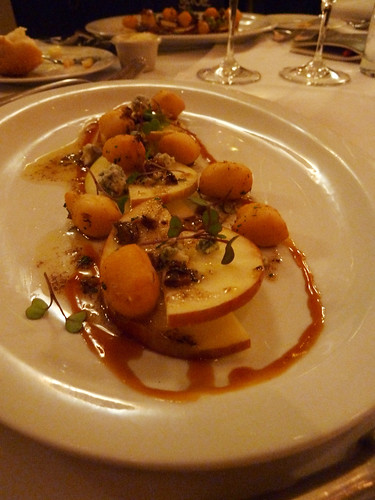
All of which made the next courses a bit confounding. We had two possible first courses on our preset menu; one was deep-fried gnocchi made with goat’s cheese, apples, bits of buttermilk blue cheese and a sage-brown butter/apple cider reduction sauce. I liked many parts of this— the twin sauces were wonderful, the gnocchi were light and airy— but I wasn’t convinced that they belonged together; a big sweet crunch of apple or the creamy sharpness of blue cheese easily steamrollered the ethereal gnocchi in the mouth. The other was Tuscan bread soup with housemade pork meatballs. The waiter had raved about the broth’s complexity, but what I tasted seemed far too Kellerized, an obsessively thin and clear broth where cloudy, rough-edged robustness would have served the classic dish better. What more than saved this dish, and again reminded you of how skilled the restaurant could be with good ingredients, were the marvelous pork meatballs, which brought funk to this dainty broth like George Clinton at a debutantes’ ball.
If I ever do a Mike G’s Rules #2, one of them will be: Don’t Order Steak In a Chef-Driven Restaurant, It Will Be the Most Boring Dish on the Menu. But I was lured in by extravagant claims made for the beef from this particular farm, and you know what? Yeah, it was good beef, a nice mineral tang, but loaded mashed potatoes, a cabernet jus and some broccoli still made for a dish as safe as a bank vault. Far better was a rainbow trout, served on a sweet potato puree, bits of smoked ham and a bourbon-based sauce— with onion rings. Crispy, hearty yet delicate, a dish that revealed new sides of itself as it danced in your mouth, this was the entree that proved that Miller could make not only good parts but good entire dishes.
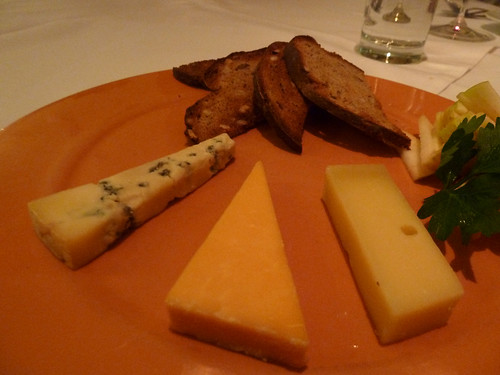
A cheese course followed, not exactly surprisingly, giving us a chance to taste the most rarefied products of several we didn’t visit. Dunbarton Blue— the same cheese Tim Dahl had been buying earlier that day— is a beautifully balanced blue, though a couple of days later at the farmer’s market, I wound up preferring and taking home a different one; Hook’s 15-year cheddar is concentrated cheese pucker, almost mushy in texture but profoundly sharp; Edelweiss Emmentaler, likewise, tastes like concentrated essence of Swiss, while Marieke gouda, perhaps my favorite of the group, has an almost liqueur-like rounded flavor.
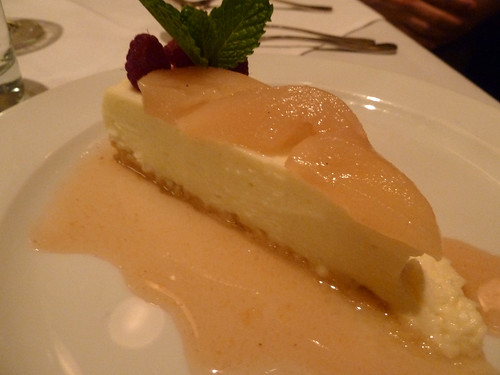
And then there was dessert, and again the hit was so glorious that it made the miss seem small, but also, that much more confounding. Caramelized apples with Hook’s 15-year cheddar and a green apple sorbet were wonderful, essence of fall’s tartness and comfort, so why were they saddled with being plopped on a dry oat streusel that had the consistency of a gravel driveway? It was like a vegan restaurant’s whole-grain-hairshirt idea of dessert. Yet a cheesecake made with Fantome Farm chevre was exquisite, weep-worthy, light as marshmallow fluff yet with the intellectual rigor of goat cheese, and set off by the lightest touch of fruit— tender vanilla-poached pears, a nectar-like peach sauce. The best cheesecake I’ve ever had? One of the best desserts I’ve had in the past two decades? Yes, yes, amazing.
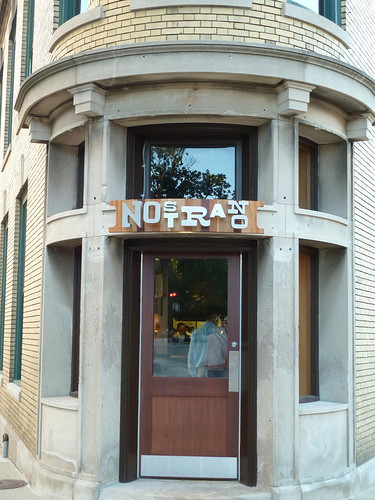
We couldn’t have eaten another bite if we’d wanted to, but having shared my story from earlier in the day at dinner, a small group of us decided to go over to Tim and Elizabeth Dahl’s restaurant just off the capitol square, called Nostrano (which means something like, simply, “Ours”) and have a drink and see how the first night had gone. The chef himself was in a decidedly mellower mood, exhausted but clearly happy with his first night, at which they’d served some 80 people over the course of the evening (capacity at one time being about 50) without blowing up or falling apart.
We asked Dahl about the direction of the menu. It’s Italian-ish, and hugely driven by the farmer’s markets, which, he said, happen nearly every day in the vicinity, beyond the Wednesday and Saturday schedule of the main market literally right outside their door. Charcuterie is a big part of the menu— he said that all his cooks were eager to make a bunch of different kinds, and he’d had to limit them to one each right now, they can make something new next week— and so is a cocktail program a la The Violet Hour, complete with mixologists in Violet-like vests, housemade bitters and the like. What struck me the most was how restless Dahl seemed to be, not only talking about how he got tired of making some of the signature desserts for Blackbird and Avec over and over but how he wanted to change the menu at Nostrano week after week, to be producing new things all the time. Some of that is simply pent-up energy— Dahl had been a generalist before joining Blackbird as a pastry chef because that’s the position that was open— but some of it, too, must be someone just itching to make things with all the great stuff he sees being sold by farmers around him.
So compared to L’Etoile’s glitz and Keller-broth-meets-Batali-meatballs contemporary vibe, Nostrano looks like a dose of specifically Chicago-style porky comfort, Italian simplicity and cocktail renaisssance. But it’s also rooted in the farm to chef connections made in Madison by L’Etoile, and while that restaurant morphs into something bigger that’s as much Santa Monica as Madison, Nostrano means there’s still a comfortable little place in an old brownstone in Madison, where they make wonders out of the stuff farmers and cheesemakers truck into town every week.
L’Etoile
1 S. Pinckney St.
Madison, WI
608-251-0500
www.letoile-restaurant.com
Nostrano
111 S, Hamilton St.
Madison, WI
608-395-3295
www.nostranomadison.com


 If you like this post and would like to receive updates from this blog, please subscribe our feed.
If you like this post and would like to receive updates from this blog, please subscribe our feed.




